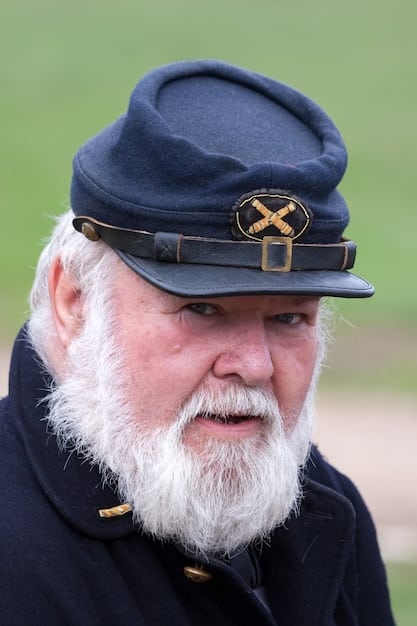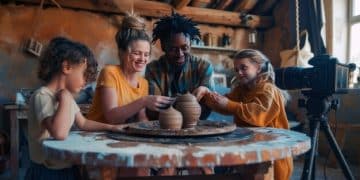Revolutionary War Reenactments: A Living History Experience in the US

Living history comes alive during Revolutionary War reenactments, offering Americans immersive experiences to witness pivotal moments, understand the lives of soldiers and civilians, and appreciate the nation’s founding principles.
Step back in time and experience the clash of arms, the fervor of ideals, and the challenges of daily life during the American Revolution through living history: immersive experiences at Revolutionary War reenactments.
Revolutionary War Reenactments: More Than Just a Show
Revolutionary War reenactments offer a unique educational and entertainment opportunity for people of all ages. These events go beyond a textbook account of history, allowing participants to witness and even participate in simulated battles, crafts, and daily routines that evoke the spirit of 18th-century America.
The Appeal of Immersive History
Why are reenactments so popular? They provide a tactile and engaging way to learn about the past, appealing to a variety of learning styles. Instead of passively reading or watching, attendees can ask questions, handle reproduction artifacts, and witness history unfold before their eyes.
Authenticity and Accuracy
The best reenactments prioritize accuracy and authenticity. Reenactors invest time and effort in researching clothing, weapons, and customs of the period. While battles are simulated, the details are often meticulously recreated to reflect historical accounts.

- Educational Value: Reenactments provide valuable historical context.
- Sensory Experience: The sights, sounds, and smells of the Revolutionary era are brought to life.
- Community Engagement: Reenactors and spectators come together to share a passion for history.
- Entertainment: The dynamic nature of the events offers an engaging form of historical entertainment.
Ultimately, Revolutionary War reenactments transform history from a distant narrative into a tangible and emotionally resonant experience, fostering a deeper appreciation for the sacrifices made by those who fought for American independence.
Experiencing the Revolutionary War: Key Components of Reenactments
Revolutionary War reenactments are multifaceted events, offering several components that contribute to the overall immersive experience. From staged battles to daily life demonstrations, these events provide valuable insights into the past.
The Battle Reenactment
The centerpiece of many reenactments is the simulated battle. Reenactors portraying Continental Army soldiers, British regulars, and other participants engage in carefully choreographed skirmishes that recreate significant battles of the Revolutionary War.
Encampments and Demonstrations
Beyond the battlefield, reenactments often feature encampments where reenactors demonstrate the daily lives of soldiers and civilians. These displays include cooking demonstrations, blacksmithing, sewing, and other period crafts.

Interacting with Reenactors
One of the unique aspects of reenactments is the opportunity to interact directly with reenactors. Attendees can ask questions about their clothing, equipment, and experiences, gaining personal perspectives on history.
- Historical Immersion: Reenactments transport attendees to another time.
- Living Education: Participants learn through direct observation and interaction.
- Cultural Preservation: These events help preserve the memory of the Revolutionary War.
- Patriotic Connection: Reenactments foster a deeper understanding of American values and heritage.
By blending battle simulations, daily life recreations, and direct reenactor interactions, these events successfully create an immersive atmosphere that educates, entertains, and preserves the memory of the Revolutionary War.
Finding Revolutionary War Reenactments: Locations and Resources
Across the United States, numerous locations host Revolutionary War reenactments of varying scales. Discovering these events requires a bit of research but promises rich and immersive experiences for history enthusiasts.
Popular Reenactment Sites
Certain historical sites are renowned for their reenactment events. These locations often played a crucial role in the Revolutionary War, adding another layer of authenticity to the experience. Notable sites include Saratoga National Historical Park in New York, Colonial Williamsburg in Virginia, and Minute Man National Historical Park in Massachusetts.
Online Resources and Event Listings
Many websites and organizations provide comprehensive listings of reenactment events across the country. Websites dedicated to historical reenactments, tourism boards, and historical societies often maintain calendars of events that are updated regularly.
Connecting with Reenactment Groups
Participating in the reenactment community, whether as a spectator or a reenactor, often begins with connecting with related groups and organizations. These groups play a significant role in organizing, promoting, and participating in these events.
- Online Event Calendars: Discover local reenactment events through online listings.
- Historical Societies: Check the websites of historical societies for reenactment information.
- Tourism Websites: Local and regional tourism websites often list upcoming reenactments.
- Reenactor Communities: Join online forums or groups to connect with reenactors and learn about events.
By utilizing online resources, exploring historical sites, and connecting with reenactment communities, history enthusiasts can easily find and attend Revolutionary War reenactments, taking a step back into American history.
Preparing to Attend a Reenactment: What to Expect and How to Engage
Attending a Revolutionary War reenactment can be an enriching experience. However, a little preparation can enhance this experience and ensure a rewarding visit. Understanding the logistics, expectations, and ways to engage adds value for both newcomers and veteran attendees.
Planning Your Visit
Before heading to a reenactment, it’s crucial to plan your visit by determining the event’s location, dates, and schedule. Confirming event admission prices and making advance reservations, if available, can also streamline the visit.
What to Wear and Bring
Selecting appropriate clothing for a reenactment is a matter of comfort and practicality. Consider wearing comfortable shoes suitable for walking across fields and uneven terrain. Additionally, weather can dictate clothing choices, so check the forecast and dress accordingly.
Engaging with the Experience
One of the most rewarding aspects of attending a reenactment is actively engaging with the experience. This involves more than just observing the battle reenactments but also taking part in conversations and asking questions.
- Review the Event Schedule: Plan your day around specific demonstrations or battles.
- Wear Comfortable Shoes: You’ll likely be doing a lot of walking.
- Ask Questions: Engage with reenactors to learn more about their roles.
- Read Event Materials: Take advantage of pamphlets and booklets to enhance your understanding.
By planning ahead, dressing appropriately, and actively engaging with reenactors and activities, attendees can gain a deeper appreciation for the Revolutionary War and create lasting memories from their reenactment experience.
The Role of Reenactors: Dedication and Historical Interpretation
Reenactors are the heart and soul of living history experiences. Their dedication, research, and passion for history make these events possible. Understanding their roles and commitment adds another layer of appreciation for reenactments.
The Commitment to Accuracy
Many reenactors dedicate countless hours to researching, creating, and maintaining historically accurate clothing, weapons, and equipment. This commitment to authenticity helps transport attendees back in time.
Portraying Different Roles
Reenactors portray a wide variety of roles, from Continental soldiers and British regulars to civilian men, women, and children. Each role requires a different set of skills and knowledge.
Sharing Knowledge and Educating the Public
Reenactors see themselves as educators, sharing their knowledge of history with the public. They are more than willing to answer questions, demonstrate skills, and help attendees understand the complexities of the Revolutionary War.
- Extensive Research: Reenactors invest time in understanding historical details.
- Diverse Roles: Reenactments feature portrayals of various historical figures.
- Educational Outreach: Reenactors actively share their knowledge with the public.
- Community Building: Reenacting fosters a sense of camaraderie among enthusiasts.
The passion and commitment of reenactors are crucial to the success of living history events, turning historical narratives into accessible and engaging experiences for all.
Benefits of Experiencing Living History: Education, Empathy, and Engagement
Revolutionary War reenactments provide numerous benefits, ranging from enhanced historical understanding to increased empathy and community engagement. These benefits extend far beyond the simple enjoyment of a day at a historical site.
Enhanced Historical Understanding
Living history events offer a dynamic and immersive way to learn about the past. By witnessing battle reenactments, exploring encampments, and interacting with reenactors, attendees gain a deeper understanding of the challenges and sacrifices of the Revolutionary War era.
Increased Empathy and Connection
Reenactments can help foster empathy by allowing participants to imagine themselves in the roles of people who lived during the Revolutionary War. This experience can create a stronger connection to the past and a greater appreciation for the values and ideals that shaped the nation.
Community and Social Engagement
Reenactments bring together people who share a passion for history, creating a sense of community and social engagement. Whether participating as a reenactor or attending as a spectator, these events provide opportunities to connect with others and learn together.
- Educational Opportunities: Reenactments provide unique learning experiences.
- Emotional Connection: Attendees develop a deeper connection to the past.
- Community Involvement: Reenactments promote community engagement and interaction.
- Personal Enrichment: Experiencing living history broadens perspectives and enriches lives.
The diverse benefits of experiencing living history: immersive experiences at Revolutionary War reenactments contribute to a more profound appreciation of American heritage and a stronger connection to the values that guided the nation’s founding.
The Future of Revolutionary War Reenactments: Innovation and Accessibility
As technology and audience expectations evolve, Revolutionary War reenactments are adapting to remain relevant and engaging. Innovations in presentation and increased accessibility are shaping the future of these immersive experiences.
Incorporating Technology
Technology continues to play an increasing role in enhancing reenactments. The integration of virtual reality and augmented reality can further immerse attendees, allowing them to experience historical events in new and exciting ways.
Expanding Accessibility
Efforts are being made to expand the accessibility of reenactments to diverse audiences. This includes providing more inclusive narratives, offering events in various locations, and incorporating educational resources for learners of all backgrounds.
Engaging Younger Audiences
Attracting younger audiences is crucial for the long-term sustainability of reenactments. Incorporating interactive elements, such as scavenger hunts, hands-on activities, and social media engagement, can help capture the attention of younger generations.
- Technological Enhancements: Innovations like virtual reality can enhance immersion.
- Inclusive Storytelling: Presenting a broader range of historical perspectives.
- Youth Engagement: Interactive activities can attract younger audiences.
- Preservation Efforts: Ensuring the continuation of reenactments for future generations.
Revolutionary War reenactments are embracing innovation and expanding accessibility to ensure that these valuable living history experiences continue to educate, inspire, and engage audiences for years to come.
| Key Point | Brief Description |
|---|---|
| ⚔️ Battle Reenactments | Simulated battles recreating historical skirmishes from the Revolutionary War. |
| 🏕️ Encampment Life | Demonstrations of daily life for soldiers and civilians, including cooking and crafts. |
| 🗣️ Reenactor Interactions | Opportunities to speak with reenactors about their roles and historical insights. |
| 📚 Educational Benefits | Enhancing historical understanding, empathy, and community engagement. |
Frequently Asked Questions
▼
A Revolutionary War reenactment is a living history event where participants recreate battles and daily life from the American Revolutionary War era, offering an immersive educational experience.
▼
You can find reenactments at historical sites, through online event listings, and by connecting with reenactment groups or historical societies. Popular locations include Saratoga and Colonial Williamsburg.
▼
Wear comfortable shoes and clothing suitable for the weather. Check the forecast and dress accordingly, as you’ll likely be walking across fields and uneven terrain.
▼
Yes, you can and are encouraged to! Interacting with reenactors is a great way to learn more about the history and their roles. They are typically very knowledgeable and willing to answer questions.
▼
Reenactments offer enhanced historical understanding, increased empathy, and community engagement, providing a unique and dynamic way to learn about the past and connect with others who share a passion for history.
Conclusion
Revolutionary War reenactments provide a unique window into the past, offering immersive experiences that educate, entertain, and inspire. By attending these events, Americans can gain a deeper appreciation for the sacrifices made by those who fought for independence and the values that shaped the nation.






